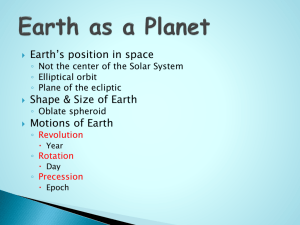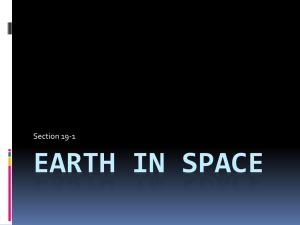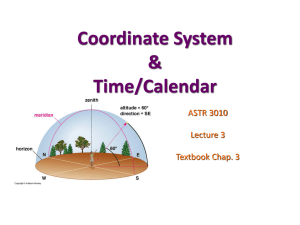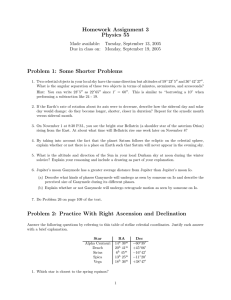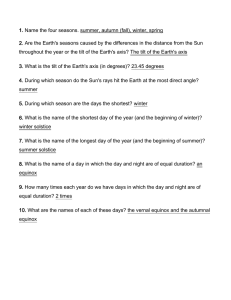Astrophysical Techniques I: Observing Strategies and Constraints Danny Steeghs
advertisement
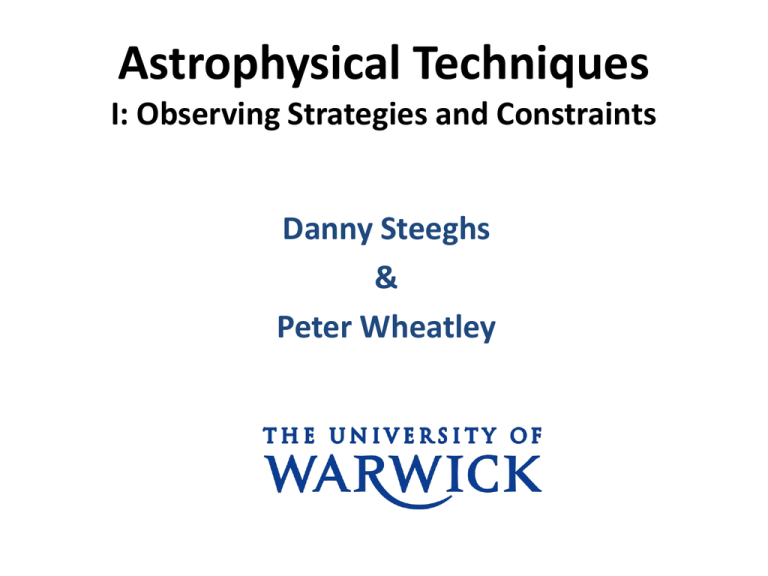
Astrophysical Techniques I: Observing Strategies and Constraints Danny Steeghs & Peter Wheatley Overview Key Topics: • • • • • Observing strategies and constraints Observing in the optical-IR X-ray and gamma-ray astronomy Radio/sub-mm observing Data archive mining Online materials: www.astro.warwick.ac.uk/people/steeghs/mpags-as2 Assignments to D.T.H.Steeghs@warwick.ac.uk and P.J.Wheatley@warwick.ac.uk , please include AS2 in subject. The celestial sphere North Celestial Pole Autumn equinox Summer solstice Earth Winter solstice Ecliptic 23.5º Vernal equinox Equator The celestial sphere ; local horizon Zenith W 90 - latitude S N E local observer frame depends on location and time The celestial sphere ; coordinates North Celestial Pole lattitude= declination (d) Earth central meridian= Vernal equinox longitude = Right Ascension (RA/a) Equatorial Coordinates (RA/Dec) • Right Ascension (R.A. or a) as longitude, often expressed in hours, minutes and seconds (or decimal hours or degrees) • Declination (d) as latitude in degrees (either decimal or sexagesimal) • Constant declination arcs are not great circles (cos d projection), thus 1 second is only 15” at equator • Current RA and Dec of the Sun? • Precession and nutation of the Earth causes movement of the equinoxes ; need to specify equinox and epoch of coordinates precession period of 25,800 yrs, +/- 24 degrees (~50”/yr) nutation period of 18.6 years, 23” amplitude e.g. equinox of reference coordinate system: B1950 or J2000 epoch of observation : 2013.0 JavaScript Sun Calculator for the lazy http://www.jgiesen.de/astro/astroJS/sunriseJS/index.htm Galactic coordinates (l,b) North Galactic Pole RA=12:51:26.282 Dec=+27:07:42.01 Galactic latitude (b) Sun central meridian= Line to galactic center RA=17:45:37.224 Dec=-28:56:10.23 Galactic plane Galactic longitude (l) 0 < l < 360 -90 < b< 90 Equatorial Projections Tools example: Simbad Identifier Query: http://simbad.u-strasbg.fr/simbad/sim-fid Tools example: Simbad Coordinate Query: http://simbad.u-strasbg.fr/simbad/sim-fcoo Tools example: NASA-SAO ADS http://adsabs.harvard.edu/abstract_service.html Sidereal time and hour-angle • Sidereal versus synodic periods ; sidereal day is 23h56m • Local Sidereal Time (LST) = R.A. of local meridian LST =0 when vernal equinox is at meridian • Hour angle reflects distance from meridian ; at LST=1h, the vernal equinox is one hour angle (15 degrees) west of meridian (equiv. LST = HA of vernal equinox) • Local hour angle of star ; HA = LST – RA [target visibility ; want to minimise HA] • Greenwich Sidereal Time (GST) is LST for reference observer at Greenwich ; LST = GST – longitude West • Observatories often have both UTC (solar day) and LST clocks Finer details Accurate pointing of a telescope to a target requires a number of additional corrections/factors to be considered: Aberration due to Earth orbit Refraction due to Earth atmosphere Proper motion of your target Annual parallax Epoch of observation versus Epoch and Equinox of coordinates • … • • • • • These are usually taken care of for you, so your main concern is establishing object visibility and feasibility of observations Additional constraints • Target accessibility for observing also affected by atmospheric effects and sky background • Atmosphere: - wavelength dependent extinction - wavelength dependent refraction - image quality aka seeing • Airmass reflects amount of atmosphere column along line of sight, above effects scale with airmass • Background: - source detection over background; optical background heavily modulated by phase and location of Moon Airmass z W S N • Airmass Zenith angle z local altitude h with h=90-z airmass: X~sec(z) E e.g. airmass ~ 2 at elevation 30 accurate at high z: Seeing Seeing histogram at Cerro Paranal (ESO-VLT) Seeing Night at Las Campanas Observatory (Magellan telescopes) [seeing degrades roughly proportional to z0.6 , so 50% worse at X=2] Extinction (more later) Wavelength dependent extinction at Mauna Kea [directly proportional to airmass] Lunar Contribution to Background • Lunar Phase : Bright time versus Dark time sky background up to 5 mags brighter near full moon and at small lunar separations, down to 3 mags at 80% • Airglow and zodiacal contributions can dominate near new Moon • Less of an issue when you go to redder wavelengths, when airglow and thermal sky components dominate Moon Sky background in V Note large dynamic range Avoid <30 Using Krisciunas & Schaefer (1991) moon background model Sky background OI 5577 [moon is not a problem in IR, but sky background certainly is!] OI 6301 OH air-glow Na HgI Na HgI HPS Tools example: StarAlt @ ING http://catserver.ing.iac.es/staralt/ Tools example: StarAlt @ ING http://catserver.ing.iac.es/staralt/ Tools example: StarAlt @ ING geodetic Location of observatory moon stats twilight target position of moon distance to moon airmass UTC http://catserver.ing.iac.es/staralt/ sunrise
